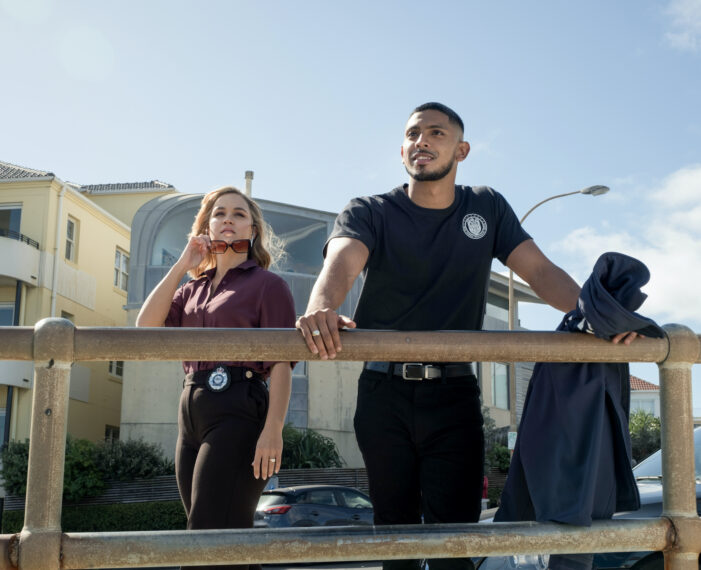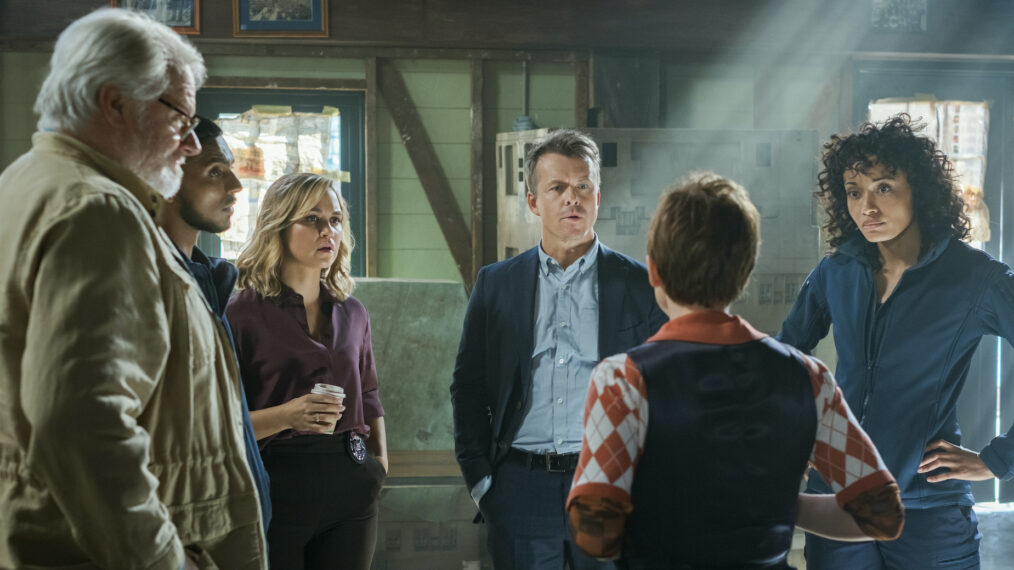NCIS has gone international.
NCIS: Sydney is the latest series in the very popular franchise, and it premieres on November 14 on CBS (in a time slot familiar to fans, Tuesdays at 8/7c, where the mothership aired for its first 18 seasons). It sees U.S. NCIS agents and the Australian Federal Police team up to keep naval crimes in check in Sydney, with NCIS Special Agent Michelle Mackey (Olivia Swann) leading the task force. Her 2IC AFP counterpart is Sergeant Jim “JD” Dempsey (Todd Lasance).
Showrunner Morgan O’Neill introduces the new team.
Across procedurals, we’ve seen agencies working together, but usually, it’s just an episode or two. But you really get to explore that over the course of the series itself. What does that allow you to do?
Morgan O’Neill: Being the first international version of a global franchise comes with all sorts of challenges, one of which is how you integrate it into the new country. NCIS exists in Australia, but when it exists in Australia, it does so under Australian law, so there has to be a kind of jurisdictional power-sharing that goes on. NCIS: Sydney was built around that exact concept, which is that NCIS Sydney comes to town and they instantly have to work with and under the authority of the Australian Federal Police. So in that sense, you’ve got, I think, in the history of the NCIS franchise, the first blended family where you’ve got these two agencies coming together, these two very different cultures coming together, and they’ve got to make it work. And that’s a lot of fun, obviously, because sometimes it does come together easily and sometimes it doesn’t. There’s obviously culture clashes. It’s a very different world that NCIS has to operate in. From that perspective, there’s a huge amount of story and a huge amount of fun to be had because it really is the coming together of two very different worlds.
What should we know about Mackey and JD as leaders and their histories?
The office is run by Captain Michelle Mackey, who’s a former Marine Corps chopper pilot. She’s a hothead; she’s a maverick. She’s very hard to work with. She’s been moved around NCIS a little bit while they try to find where she can do the least damage. But she’s incredibly good at what she does. She’s very instinctive in terms of the way she runs her investigations, but it means that she’s a really tough task master and she’s a real hard nut to crack. And so it makes it especially interesting to see how the 2IC, who’s an Australian Federal Police force sergeant, Jim Dempsey, gets to manage her because effectively he’s managing her for the rest of the team. In a funny way, it’s this kind of dance between the boss and the real boss. And it’s interesting, JD has to adjust the way he runs a squad to take into account the fact that he’s working for this maverick.
Daniel Asher Smith/Paramount+
And they clash a little bit at first, I won’t lie to you; as you’ll see in the first episode, they really do butt heads. As you can imagine, there’s a sense of pride at who has control of the situation, who runs the investigation, whose jurisdiction it is. The nature of NCIS is that there are a lot of crimes that kind of fall in that gray area between jurisdictions, and that’s where a lot of the fun is to be had in the episodes. So they come together like bulls initially, and what’s exciting is to see how they work through those problems.
As you would know, being a fan of the show, one of the key things about NCIS is that it’s really, at its heart, a family drama, and we have the opportunity, as I said, to create this first blended family within the history of the franchise. We really have an opportunity to see these people coming together for the very first time. Because, unlike other iterations of the franchise where the audience drops into a group of people who already know each other, who already function as a team, we see them from day one and everything that entails and all the building of trust and sometimes the fracturing of trust and the testing of those bonds.
It seems like the only thing that they can agree on is they don’t want to be working together. What does it take for them to open up to each other? Is it one case? Small moments over multiple cases?
They have to come together as a team really quickly because it’s not like the crimes are going to stop for them to work out their jurisdictional issues. You actually see it in the opening episode. There are moments where, almost in spite of themselves, they feel like they’re coming together, like a small bond is forming, moments of trust, moments, where they see each other, reflected in themselves, moments where they’re quietly impressed but begrudgingly don’t want to really admit it. [They have] two very different ways of approaching law enforcement. And while at first, they seem really far away, actually, when you look at them, and across the course of the first season, you actually work out that JD and Mackey are more like yin and yang than they are competitors. They really do complement each other, and they grow kind of close.
What excited you the most about exploring the rest of the team — Evie (Tuuli Narkle), DeShawn (Sean Sagar), Penrose (William McInnes), and Blue (Mavournee Hazel)?
I lived in LA for a long time, and I met a couple of guys who reminded me a lot of DeShawn as he emerged from the page. His fundamental quality is he’s got this endless curiosity, and for me as a creator, it’s a beautiful concept to work with because he can be the eyes of the rest of the world, endlessly curious about Australia, working out who these weird people are that inhabit the world’s largest island on the southern tip of the Southeast Asian archipelago. DeShawn is able, through his curiosity, to really pull the lid back and look at what makes us tick and who we are and what this country’s all about. So that kind of sense of openness, I describe him as a kind of American Paddington bear.


Daniel Asher Smith/Paramount+
His openness comes directly into conflict with Evie’s kind of sassy territorialness, I suppose. It’s funny — when we first cast Tuuli Narkle, who’s a relatively new but incredibly gifted Australian actor who’s just won a bunch of awards for basically her first big role, I said to her, “Do you know the show?” She said, “I love the show. I’m a massive fan.” I said, “Who’s your favorite character?” She said, “Oh, it’s a no-brainer. It’s DiNozzo [played by Michael Weatherly on NCIS].” It was interesting because she’s got a little bit of DiNozzo in her. She’s got a little bit of that constantly chipping away at her colleagues, enjoying taking the piss a little bit. From that perspective, the combination of an endlessly curious and a sassy, kind of provocative, territorial character makes for a huge amount of fun. We were blessed with the reality that the actors who play those roles ended up really getting on, so that brotherly sisterly banter comes pretty naturally to them, which I hope is a lot of fun for the audience to see.
The challenge when you’re creating another iteration of such a famous franchise is that you don’t want to repeat characters. You don’t want to just take the cookie-cutter version of something and make it your own. And when it comes to a character like the forensic scientist in a show like this, people go so quickly to the character of Abby [Pauley Perrette] because she’s so iconic. She kind of defined that role. We wanted to make sure that we weren’t replicating that. Then we found Mavournee Hazel who plays Bluebird Gleeson, who is out of her depth. She has complete imposter syndrome like she shouldn’t be there. She’s too young, she’s too inexperienced. She’s carrying a whole bunch of really unusual, interesting backstory that we’ll peel away as the seasons go on. But she’s incredibly good at her job. She’s kind of socially awkward. I just found the combination of all those things made her feel very real to me. I’ve worked with a lot of people who work in the world of science, and she just felt like she resonated that sense of intellectual power and social awkwardness, which I loved.
So she comes into the first episode, not really even deserving to be there. She’s on a probationary program that the Australian Federal Police has run. She’s not even a fully-fledged forensic scientist, and she’s forced to work with the oldest, wisest owl on the crew, Doc Roy, who’s a former Australian Navy medic and now forensic pathologist. He’s emotionally shut down for some reason that we’ll get into as the show evolves. But what’s really interesting to watch is watching Blue slowly reanimate the emotional side of Doc Roy. There’s a beautiful dance that goes on throughout the first season where she just slowly gets under his skin and slowly brings him back to some kind of emotional life, which is what happens in families sometimes. I’m biased; I cast them, but they’re such beautiful actors and lovely people that watching that relationship flourish is, I think, part of the real joy of the first season.
How did you want to make the headquarters unique?
I’m partial, but I think we have the best headquarters of all. We’re the only version of the show, I believe, whose set is actually on location. Sydney is the world’s largest harbor, and it has a huge foreshore. We were very fortunate enough to find a huge warehouse that sits right on Sydney Harbour that looks out onto the harbor so that when our characters get up from the bullpen to go and see where that case begins, they literally walk out through the front doors and they’re on Sydney Harbour. That, for us, is an enormous advantage because there’s no trickery in making it feel like it is where it is. It is there, and you can hear the sound of the ferries passing and the Navy ships passing in front. You can hear the slap of the water on the piers below. That, for us, was a huge advantage, I think. It really gave a sense of authenticity to the show because so much of the show was set in that headquarters.
Interestingly, we had some of the real NCIS agents come through on a set tour, and I was talking to one of them, and he was shaking his head. I was like, “What’s going on? You don’t like it?” He went, “No, no, it’s amazing. It feels like my very first field office in Connecticut.” He said their NCIS office out there was a little rundown. As you’ll see when you see the show, it feels like an old Navy storehouse because it is an old Navy storehouse. He said that his very first office was very similar to that, which made me very excited because it felt like we were really tapping into the authenticity of that world.
NCIS: Sydney, Series Premiere, Tuesday, November 14, 8/7c, CBS
This story originally appeared on TV Insider

